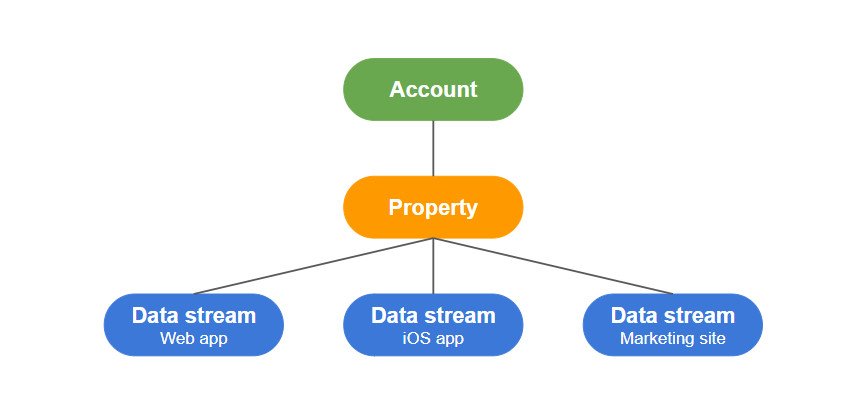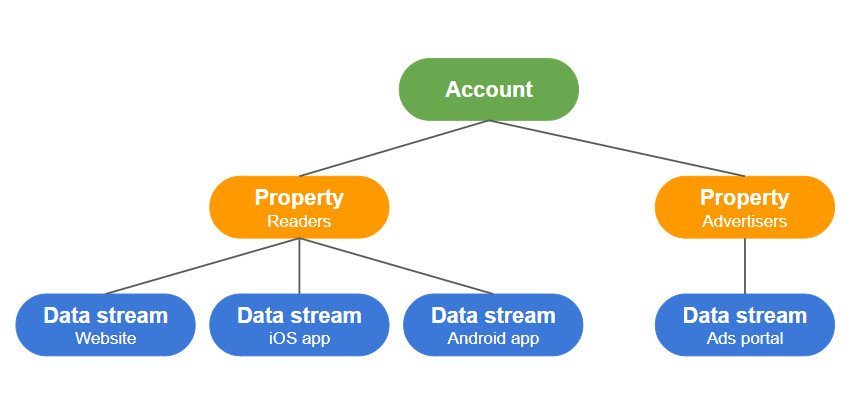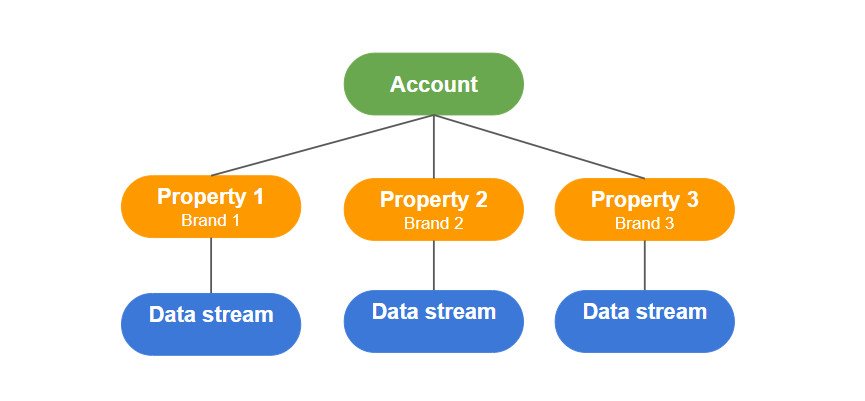Understanding how to structure your Google Analytics 4 account is pivotal for maximizing your data insights and making informed decisions. This guide is designed to help you, whether you’re a solo entrepreneur or part of a larger enterprise, navigate the new landscape of GA4. We’ll dive into the core components of GA4 and illustrate this with expanded, descriptive examples for businesses of various sizes.
The Core Components: Account, Property, and Data Streams
Before we explore examples, let’s decode the three foundational elements of Google Analytics 4: the account, property, and data streams.
The Account
The account is the umbrella under which all your GA4 properties reside. It’s governed by specific terms of service, often delineated by region. For businesses centralized in one region, a single account suffices. However, if you have multinational operations or different regional entities, consider setting up an account for each to keep data governance clean and compliant.
The Property
Properties are subsets within your account, each representing a unique user base or product line. Think of properties as individual containers for data from specific brands, applications, or service lines within your business. This is the level where data processing occurs and where you can create links to other Google products for a more integrated view.
The Data Streams
At the granular level, data streams are where the data flow originates. Each interaction platform, such as a website or mobile application, should have its own stream within a property. This allows for precise control and customization of data collection settings for each type of user interaction.
With these fundamentals in mind, let’s look at descriptive examples of different business types and how they might structure their GA4.
The Most In-Depth
Google Analytics 4 (GA4) Course
Master GA4 custom reports, create custom events & conversions, set it up on Shopify, WordPress, and much more.
Real-World Examples
John’s Boutique Beekeeping Blog
John is a beekeeping enthusiast who runs a boutique blog dedicated to all things apiculture. His digital presence is straightforward — a single website where he shares tips, stories, and sells beekeeping supplies.
His GA4 structure is simple: one account representing his blog as a legal entity, one property for his blog’s data, and one data stream directly linked to his website.
This structure allows John to focus on growing his niche community and analyzing user interaction with his content.

Mary’s Rising SAAS Empire
Mary’s business is a burgeoning SAAS platform offering innovative solutions to clients. Her digital assets include a main web application, a dedicated marketing website, and a recently launched iOS app.
To capture the full customer journey, Mary utilizes a single property within her GA4 account to collectively analyze data across the three distinct platforms — each represented as a data stream.
This structure allows Mary to understand how users move from discovering her service on the marketing site to engaging with the web or mobile app, providing invaluable insights for user experience and marketing strategy optimization.

Ram’s News Media Conglomerate
Ram’s enterprise is a high-traffic news and media website with a significant mobile app presence and a dedicated portal for advertisers. Due to the distinct nature of his user bases — millions of readers and a separate group of advertisers.
Ram sets up two properties within his GA4 account. The reader property has three data streams to capture interactions on the website and both mobile apps, while the advertiser portal is a singular stream within its own property.
This separation allows Ram to tailor his analytic strategies to the unique needs and behaviors of readers and advertisers, optimizing content and ad placement effectively.

Julia’s Multi-Brand eCommerce Operation
Julia oversees a massive eCommerce operation with three distinct brands, each offering hundreds of products across seven European countries.
To manage this complexity, Julia’s GA4 account consists of three properties, one for each brand. Each brand is further segmented into seven data streams, one for each country they operate in.
This structure allows Julia and her team to analyze brand performance and customer behavior in each market separately, enabling targeted marketing strategies and operational adjustments at both the brand and regional levels.

Conclusion
Setting up your Google Analytics 4 account is a strategic process that should reflect your business’s operational structure and analytical needs.
From John’s single-stream boutique blog to Julia’s multi-brand, multi-country eCommerce empire, the way you set up your GA4 can significantly impact the insights you derive and the decisions you make.
Consider the scale, diversity, and objectives of your digital assets as you migrate to or start with Google Analytics 4, and use this guide as a stepping stone to a more data-informed future.

